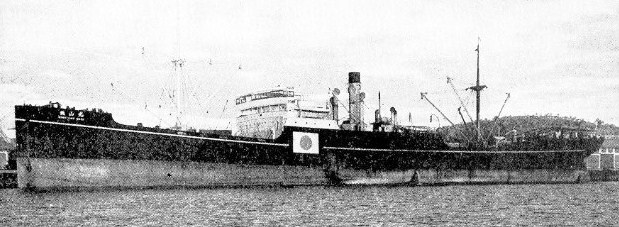RIKUGUN YUSOSEN
 (Sister MOMOYAMA MARU, prewar)
(Sister MOMOYAMA MARU, prewar)
KAIMEI MARU:
Tabular Record of Movement
© 2018 Bob Hackett
E 1918:
Hong Kong, United Kingdom. Laid down Hong Kong & Whampoa Dock Co. Ltd., as Yard No. 563, a 5,226–ton British WW1 Type B Standard Cargo Ship for The Shipping Controller, London, England.
1919:
Launched and named WAR BOMBER.
1919:
Completed and renamed PIONIER. Sold to Lloyd Royal Belge, Antwerpen, Belge (Belgium).
1930:
Transferred to Cie. Maritime Belge.
1939:
Sold to Panama and renamed CARMAR.
1941:
Sold to Kaiyo Kisen K. K. of Kobe. Renamed KAIMEI MARU.
13 November 1941:
Requisitioned by the Imperial Army (IJA) for service as a troop transport. Allotted Army No. 262.
8 December 1941: :
The Pacific War Begins.
17 December 1941: The Invasion of Lamon Bay, Southern Luzon:
Imperial General Headquarters launches the combined IJA and IJN Lamon Bay Operation. The Army force consists of Gen (later Field Marshal) Count Terauchi Hisachi’s Southern Expeditionary Army. Its 14th Army, under LtGen Homma Masaharu, fields MajGen Morioka Susumu's Invasion Unit of about 7,000 troops consisting of elements of the 16th Infantry division: 20th Infantry, 22nd Field Artillery, HQ and II Battalion, 16 HQ Company, 16th Eng Battalion, 16th Recon Battalion, 3/45 AA Company, 16th Transport, 16th Signal Company, 16th Medical Unit and 16th Veterinary Unit. Two AA and one Signals regiments are stationed on IJA transports.
The invasion units are embarked on 20 IJA transports: KAIMEI, BENGAL, DAINICHI, DURBAN, KAYO, KITANO, KOFUKU, LISBON, NAGATO, NICHIREN, RYOKA, RYUYO, SHINSEI, SHINSHU, TAIAN, TATSUNO, TOFUKU, TOYAMA and TOYOHASHI MARUs and TAMON MARU No. 5.
The naval force consists of Vice Admiral (later Admiral) Kondo Nobutake's (35)(former CO of KONGO) Southern Force, Philippines Invasion Group that includes Vice Admiral Takahashi Ibo’s (35)(former CO of YAMASHIRO) Third Fleet. Rear Admiral (later Vice Admiral) Kubo Kyuji’s (38) (former CO of KAGA) Invasion Unit consists of his 1st Base Force HQ, in light cruiser NAGARA, 1st Quartermaster Ports and Docks Unit and 1st Naval Signal Unit, aboard HAKUSAN MARU, 1st Naval Guard Unit, aboard KIMISHIMA MARU, 1st Naval Survey Unit in SENKO MARU and Captain (later Vice Admiral) Mori Kunizo's (40)(former CO of SATA) Sasebo No. 1 and 2 Combined Special Naval Landing Force (SNLF) aboard MYOKO MARU.
The convoy’s escort consists of light cruiser NAGARA (F), heavy cruiser ASHIGARA, destroyers TOKITSUKAZE, YUKIKAZE, KAWAKAZE, SUSUKAZE, UMIKAZE, YAMAKAZE, minelayer AOTAKA, minesweepers W-7 and W-8, auxiliary gunboat/minelayer IKUSHIMA MARU, auxiliary gunboats BUSHO, KEIKO, KANKO and MYOKEN MARUs, auxiliary subchasers SHONAN MARU No. 17 and TAKUNAN MARU No. 5 and auxiliary netlayer FUKUEI MARU No. 15.
At 1500, the Invasion Force departs Koniya, Amami Oshima for Lamon Bay, Quezon, Philippines.
24 December 1941:
At 0200, the Invasion Force arrives at Lamon Bay. The landings proceed without strong opposition.
26 January 1942:
KAIMEI MARU departs Tsingtao, China in a convoy also consisting of DURBAN, FUJI, KAYO, KOFUKU, LISBON, NICHIREN, SHINSEI and UME MARUs.
27 January 1942:
Destroyer HASU departs Shanghai joins the convoy off the Yangtze estuary.
29 January 1942:
15 miles S of the Taichow Islands. KAIMEI MARU is in a convoy also consisting of transports LISBON, KOFUKU, UME, DURBAN, KAYO and SHINSEI MARUs, civilian passenger/cargo ship FUJI MARU and seven unidentified merchant ships. At 0730, destroyer HASU and auxiliary gunboat SHINKO MARU No. 1 GO begin to escort the convoy. At 1630, escort is taken over by minelayer SOKUTEN and gunboat SHINKO MARU No. 1 GO is detached.
30 January 1942:
Arrives at Taichow Islands.
2 February 1942:
KAIMEI MARU departs Mako for Haiphong, Vichy French Indochina in a convoy now also consisting of DURBAN, FUJI, KAYO, KOFUKU, LISBON, SHINSEI and UME MARUs escorted by torpedo boat KASASAGI.
After passing the anti-submarine net at the harbor entrance, LISBON MARU takes a faulty course. Soon after, at 0855 (JST), she hits a Japanese defensive mine.amidships, becomes unnavigable and floods. 19 men are killed/wounded. Due to the danger of sinking, all hands are ordered to abandon ship. Afterwards, a naval tug arrives, takes the drifting ship in tow and beaches her on the S coast of Boko To (Penghu Tao), Formosa.
1942:
Sold to Tochigi Shoji K.K., Wakamatsu.
September 1942:
KAIMEI MARU departs Nagoya for Otaru in ballast in a convoy also consisting of cargo ships CHITA and TENRYU MARUs to pick up coal at Karafuto.
4 September 1942:
Off Kuji Bay, Iwate Prefecture, NE coast of Honshu. At 1640, LtCdr (Rear Admiral-Ret) Thomas B. Klakring's (USNA '27) USS GUARDFISH (SS-217) fires one torpedo and gets a hit in KAIMEI MARU's No. 4 hold. At about 1720, she sinks at 40-14N, 141-51E. 10 crewmen are KIA.
USS GUARDFISH also torpedoes and sinks cargo ships CHITA and TENRYU MARUs in Kuji Bay.
Author's Note:
Thanks to Erich Muehlthaler of Germany.
Bob Hackett
Back
to IJA Transports





